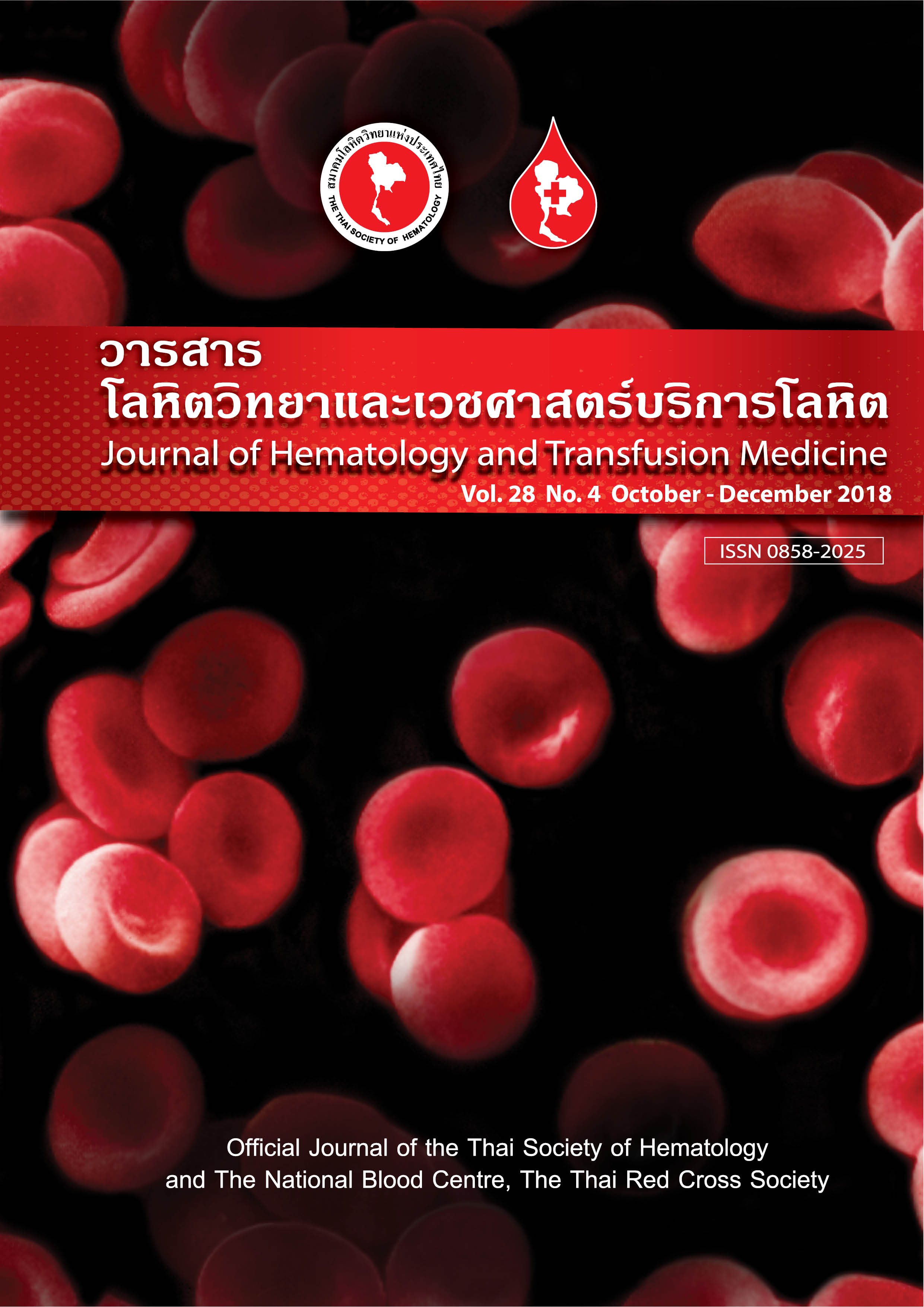Study of hematologic change among patients with sepsis at internal medicine wards
Keywords:
sepsis, hematologic changeAbstract
Background: Sepsis is a serious medical condition caused by an overwhelming immune response to infection. The hematological changes are related to clinical sepsis but the evidence is limited in Thailand.
Objective: The study aimed to identify the incidence of hematologic changes and correlation with other organs among patients with sepsis.
Method: This was a retrospective review of patients with sepsis admitted to medicine wards from
January 2012 to July 2012. Data on medical records were reviewed at the first day (day 0) and the seventh day
of sepsis (day 7).
Results: The study involved a total of 196 patients with 37 cases of septic shock (18.9%). The
median age was 70 years (range 16-105). Eighty-seven patients (44.4%) were male and 109 patients (55.6%) were female. The primary sources of sepsis were predominantly UIT (58 cases, 29.6%), followed by septicemia (39 cases, 19.39%), pneumonia (33 cases, 16.8%), diarrhea (22 cases, 11.2%), and cellulitis (18 cases, 9.2%). Identified pathogen were 21 cases (10.7%) with Gram positive cocci, 95 cases (48.5%) with Gram negative bacilli, 13 cases (6.6%) with other (virus, fungus, mycobacterium, spirochete, parasite), and 67 cases (34.2%) unknown. Most cases had a duration of sepsis ranging from 1-3 days (120 cases, 61.2%), the second frequent ranged from 4-7 days (57 cases, 29%), and 19 patients (9.7%) had clinical sepsis more than 7 days. The hematologic changes found were anemia with 80 cases (40.8%) having hemoglobin (HB) less than 10 g/dL and 77 patients (39.3%) had decreased hematocrit (HCT) more than 3% at day 7. In all, 40 (20.4%) patients had white blood cell (WBC) count below 4 x109/L or more than 12 x109/L day 7. The decreased HB, HCT and neutrophil counts (PMN) while increased platelets significantly correlated with long duration of sepsis (p = 0.014) but only decreased PMN related to a long duration of shock (p = 0.009). Decreased albumin up to 1 g/dL was associated with increased prothrombin day 7 (p = 0.047). Increased creatinine was correlated with increased partial thromboplastin time day 7 (p = 0.027).
Conclusion: The incidence of hematologic changes in sepsis was high. Hematologic changes were related to factors including long duration of sepsis more than 7 days and long duration of shock, however without significance
Downloads
References
2. Angus DC, Linde-Zwirble WT, Lidicker J, Clermont G, Carcillo J, Pinsky MR. Epidemiology of severe sepsis in the United States: analysis of incidence, outcome, and associated costs of care.Critical Care Med. 2001;29:1303-10.
3. Means RT Jr. The anemia of infection. Baillieres Best Pract Res Clin Haematol. 2000;352:1011-23.
4. Peter M.C. Klein Klouwenberg, David S.Y. Ong, Marc J.M. Bonten, Olaf L. Cremer. Classification of sepsis, severe sepsis and septic shock: the impact of minor variations in data capture and definition of SIRS criteria. Intensive Care Med. 2012;38:811-9.
5. R Phillip Dellinger, Mitchell M Levy, Andrew Rhodes, Djillali Annane, Herwig Gerlach. Surviving Sepsis Campaign: International Guidelines for Management of Severe Sepsis and Septic Shock: 2012. Critical Care Med. 2013;41:580-637.
6. Richert E. Goyette, Nigel S. Key, and E. Wesley Ely. Hematologic Changes in Sepsis and Their Therapeutic Implications: Sem in Resp and Crit Care Med. 2004;25:645-59.
7. William CM. The Hematologic System as a Marker of Organ Dysfunction in Sepsis. Mayo Clinic Proc. 2003;78:869-81.
8. Smoller BR, Kruskall MS. Phlebotomy for diagnostic laboratory tests in adults: pattern of use and effect on transfusion requirements.N Engl J Med. 1986;314:1233-5.
9. Georges H, Leroy O, Vandenbussche C, Guery B, Alfandari S, Tronchon L, et al. Epidemiological features and prognosis of severe community-acquired pneumococcal pneumonia. Intensive Care Med. 1999;25:198-206.
10. Baughman RP, Lower EE, Flessa HC, Tollerud DJ. Thrombocytopenia in the intensive care unit. Chest. 1993;104:1243-7.
11. Weiss G, Goodnough LT. Anemia of chronic disease. N Engl J of Med. 2005;352:1011-23.
12. Taylor FB Jr., Toh CH, Hoots WK, Wada H, Levi M. Towards definition, clinical and laboratory criteria, and a scoring system for disseminated intravascular coagulation. Thromb Haemost. 2001;86:1327-30.
13. Matthias John and Soeren Hoernig. Anemia and Inflammation in COPD. Chest. 2005;127:825-9.


